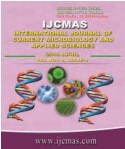


 National Academy of Agricultural Sciences (NAAS)
National Academy of Agricultural Sciences (NAAS)

|
PRINT ISSN : 2319-7692
Online ISSN : 2319-7706 Issues : 12 per year Publisher : Excellent Publishers Email : editorijcmas@gmail.com / submit@ijcmas.com Editor-in-chief: Dr.M.Prakash Index Copernicus ICV 2018: 95.39 NAAS RATING 2020: 5.38 |
A detailed soil survey was undertaken in central state farm Jetsar, Sri Ganganagar, Rajasthan, India representing the arid climate with the aim of to assess the status and potential of land resources for the suitability and production potential of soils for chickpea. The area of the farm has been divided into three major landforms viz., sand dunes, reclaimed sand dunes and aeofluvial flood plain. Based on the variation in physiography and landforms, eight soil pedons were identified in the farm. Pedon P1 & P2 occurring on sand dune and reclaimed sand dune which are sandy deep, mixed, calcareous, Typic Torripsmments whereas pedons from P3 to P8 occurring on aeofluvial flood plains which are deep, calcareous, coarse loamy to fine silty Typic/Sodic/Fluventic Haplocambids and Oxyaquic Torrifluvents. Soils of the farm belong to very deep category ranged from 135-195 cm, sandy to clay textured developed on aeolian and alluvium parent material. These soils are moderately alkaline (8.25 pH) to strongly alkaline (9.56 pH), very low (0.02%) to low (0.29%) in organic carbon, non saline (EC 0.13) to strongly saline (EC 7.50 dsm-1), low (1.95%) to high (19.51%) in calcium carbonate. Further, soils were low in available nitrogen, low to medium in available phosphorus, low to medium in available potassium whereas soils were low in available Fe and Mn, and high in available Zn and Cu. Soil has been assessed for suitability of chickpea as per the criteria given by Naidu et al 2004. Soils of the pedon P3, P6 and P7 were moderately suitable, whereas pedon P5 was marginally suitable for the cultivation of chickpea. Soils of pedon P1, P2, P4 and and P8 were not suitable for the chickpea cultivation due to extreme values of texture, pH and organic carbon respectively. Potentially soils of pedon P3, P5, P6 and P7 were moderately suitable in contrast to P2 and P8 which are marginally suitable. Yield of the farm can increased 9-36% with soil and fertility related managements.
 |
 |
 |
 |
 |